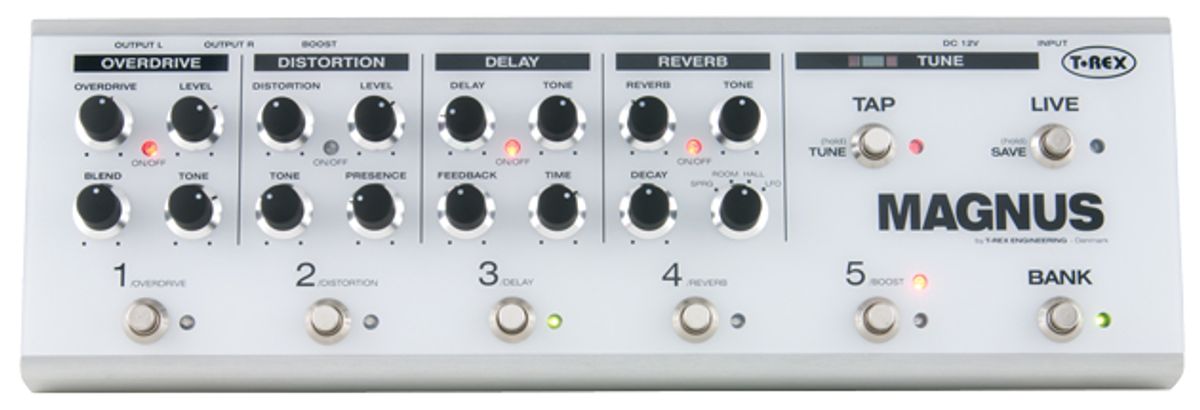This streamlined and affordable multi-effect unit delivers ease and performance.
Multi-effects units can be very practical tools, yet they remain—well, let’s just say it—uncool for many players. Given that stigma, many boutique and high-end builders steer clear of do-it-all devices, though recent releases from companies like Electro Harmonix, Empress, and Strymon suggest a new open-mindedness about the format.
Denmark’s T-Rex enters the multi-effect derby with the semi-analog Magnus, which bundles overdrive, distortion, delay, reverb, boost, and a tuner. Rather than cramming everything into a compact enclosure, T-Rex gambles that a slightly larger unit with an appealing and easy-to -use design will find takers.
Easy To Get Around
With its milky-white face, silver edges, and stark facade, Magnus exudes Scandinavian minimalist chic. Despite having five effects, it’s surprisingly light, and only slightly longer than a compact Pedaltrain Nano board.
There are four knobs per effect, save for the single-knob boost. Each effect has a dedicated footswitch, and there are three additional ones: a “live” switch that toggles between preset and manual modes, a bank selector, and a tap tempo/tuner switch. The simple layout (and thoughtful touches like the recessed boost knob) reflects a concern for the realities of stage life. However, the footswitches and knobs feel less robust than they might, given Magnus’s gig-oriented mission.
Modern Functionality with Analog Soul
In Magnus’s “what you see is what you get” live mode, the pedals operate as five independent effect units. Meanwhile, preset mode lets you store up to 10 combinations in two five-preset banks, differentiated by red and green lights and selectable via the bank button. Here you select specific presets via the five bypass switches.
Access to programmable presets is handy in many performance situations. Say you’re using overdrive and a dash of reverb for your rhythm sound: When it’s time for a solo, you might choose a preset that bypasses overdrive and engages distortion and delay simultaneously—a move that might be tricky to execute with three individual pedals. However, while Magnus lets you save effect combinations, it doesn’t store individual effect settings. Some may find this arrangement limiting. Others may appreciate its intuitive simplicity.
Taming a Tuna
The tuner uses green and red lights to signify sharpness and flatness. Unfortunately, there is no alphanumeric display to indicate which note you’re tuning. This can be challenging, because the tuner reacts to whatever note it hears first. If you’ve knocked a given string way out of tune, it can be hard to pinpoint your target pitch. The fact that the tuner mutes your signal compounds the problem—there’s no audible reference to verify whether you’re tuning to, say, E or Eb.
Magnus Speaks
Fake, digital-sounding overdrive and distortion sounds are usually the Achilles’ heel of multi-effects units. But Magnus’s all-analog gain section obliterates the notion that a multi-effects unit can’t deliver killer overdrive and distortion.
The overdrive section has gain, tone, and level controls, plus a less common blend knob that lets you mix your clean tone with the dirt, adding clarity and articulation. The drive has a nice Tube Screamer-like character that can add a slight edge or beefy crunch.
Ratings
Pros:
Excellent sounds in an easy–to–use, intuitive layout.
Cons:
Preset mode doesn’t save effect settings. Problematic tuner display.
Tones:
Playability/Ease of Use:
Build/Design:
Value:
Street:
$399
Company
t-rex-effects.com
The distortion pedal has great range, from a smooth, violin-like lead sound that works well with delay and reverb, to a more Rat-like, in-your-face attack. The tone control provides much color as well. At its darkest settings, individual notes never got muddy. With the tone maxed, notes are strikingly clear without ever reaching the icepick threshold. The presence control adds even more tone-shaping options, lending Marshall-like brilliance when turned up high.
Delay and reverb effects run parallel to the dry signal. The delay is based on T-Rex’s Tap Tone, and you get up to a second of delay time. There’s also a tap tempo footswitch. But while the manual says the delay is capable of a “space rock freak out,” you won’t get infinite repeats even with the feedback maxed. The tone control is a high-cut filter, and analog warmth is apparent at all settings. This is one of Magnus’s nicest effects.
There are four reverb types: spring, room, hall, and LFO. The spring and room reverbs are a bit on the dry side, and at times I heard a slight metallic tinge. The LFO mode recalls the sound of a Roland JC-120 in all its chorused glory, while hall mode is the silkiest option.
The Verdict
Magnus is built on a core of solid-to-great effects. That’s no real surprise given the quality of most T-Rex pedals to date. If your effects needs are many and specialized, Magnus may seem limited. It doesn’t offer any routing options—you can’t, for example, insert a pedal between two Magnus effects, or place the delay and reverb in an amp’s effects loop while running the gain section into the preamp. But if you simply need a killer-sounding core of pedals (and are tired of hassles like chasing down bad pedal cables and stompboxes that fall off the board), Magnus could be worth its weight in gold. And by any standard, 400 bucks is not a bad price for five very good effects in one convenient package.

